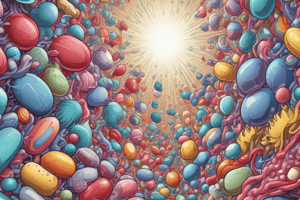Podcast
Questions and Answers
What is the primary mechanism of bacteriostatic agents?
What is the primary mechanism of bacteriostatic agents?
- Directly killing bacteria
- Interfering with protein synthesis (correct)
- Disrupting the cell wall
- Damaging DNA
Why are bactericidal agents preferred in severe infections or individuals with compromised immune systems?
Why are bactericidal agents preferred in severe infections or individuals with compromised immune systems?
- Because they target a broad spectrum of bacteria
- Because they interfere with protein synthesis
- Because they directly kill bacteria leading to rapid reduction in bacterial numbers (correct)
- Because they disrupt the cell wall
What is the primary purpose of taking broad spectrum antibiotics?
What is the primary purpose of taking broad spectrum antibiotics?
- To treat antibiotic-resistant bacteria
- To prevent potential bacterial infections before the species is determined (correct)
- To directly kill bacteria
- To target a narrow spectrum of bacteria
What are the three main targets of antibiotics?
What are the three main targets of antibiotics?
What is the primary method by which bacteria develop antibiotic resistance through binary fission?
What is the primary method by which bacteria develop antibiotic resistance through binary fission?
How do bacteriostatic agents allow the host's immune system to eradicate bacteria?
How do bacteriostatic agents allow the host's immune system to eradicate bacteria?
Why are narrow spectrum antibiotics often used when antibiotic-resistant bacteria are present?
Why are narrow spectrum antibiotics often used when antibiotic-resistant bacteria are present?
What is the main reason cited by the WHO for the rise of antibiotic resistance?
What is the main reason cited by the WHO for the rise of antibiotic resistance?
What is the result of multi-drug resistance in bacteria?
What is the result of multi-drug resistance in bacteria?
What is the outcome of using bacteriostatic agents?
What is the outcome of using bacteriostatic agents?
What is the term for the process by which bacteria share genetic material through viruses?
What is the term for the process by which bacteria share genetic material through viruses?
What determines the suitability of bacteriostatic agents in individuals?
What determines the suitability of bacteriostatic agents in individuals?
What is the result of antibiotic resistance on a global scale?
What is the result of antibiotic resistance on a global scale?
What is the term for the process by which bacteria release genetic material that can be taken up by other bacteria?
What is the term for the process by which bacteria release genetic material that can be taken up by other bacteria?
What is the primary method by which bacteria develop antibiotic resistance through interactions with other bacteria?
What is the primary method by which bacteria develop antibiotic resistance through interactions with other bacteria?
What is the effect of overprescription of antibiotics on bacterial populations?
What is the effect of overprescription of antibiotics on bacterial populations?
Study Notes
Antibiotics and Their Effects
- Antibiotics can be bacteriostatic or bactericidal
- Bacteriostatic antibiotics inhibit bacterial growth, allowing the host's immune system to eradicate the bacteria
- Bactericidal antibiotics directly kill bacteria, often preferred in severe infections or in individuals with a compromised immune system
Spectrum of Antibiotics
- Antibiotics can be broad spectrum or narrow spectrum
- Broad spectrum antibiotics target many types of bacteria and are often taken prophylactically
- Narrow spectrum antibiotics target a few types of bacteria and are usually taken when antibiotic-resistant bacteria are present
Antibiotic Mechanisms
- Antibiotics target three main things:
- Cell wall and membranes surrounding bacterial cells
- Machineries that make nucleic acids (DNA and RNA)
- Machinery that produces proteins (ribosome and associated proteins)
Antibiotic Resistance
- Antibiotic resistance can be transferred by vertical or horizontal transfer
- Vertical transfer occurs through mutations during bacterial reproduction
- Horizontal transfer occurs through the exchange of genetic material between bacteria
Methods of Horizontal Transfer
- Conjugation: resistance genes are transferred between bacteria via plasmids
- Transduction: resistance genes are transferred via viral phages
- Transformation: resistance genes are released from live or dead bacteria and picked up by another
Scale and Significance of Antibiotic Resistance
- Antibiotic resistance is listed as one of the top global public health and developmental threats by the WHO
- Misuse and overuse of antibiotics are main reasons for antibiotic resistance
- Multi-drug resistance has led to an increasing incidence of disease
- Antibiotic resistance increases fatalities, healthcare costs, and the emergence of infections that are difficult to treat
Studying That Suits You
Use AI to generate personalized quizzes and flashcards to suit your learning preferences.
Description
Learn about the mechanisms of bacteriostatic and bactericidal antibiotics, including how they inhibit bacterial growth and interact with the host's immune system.




